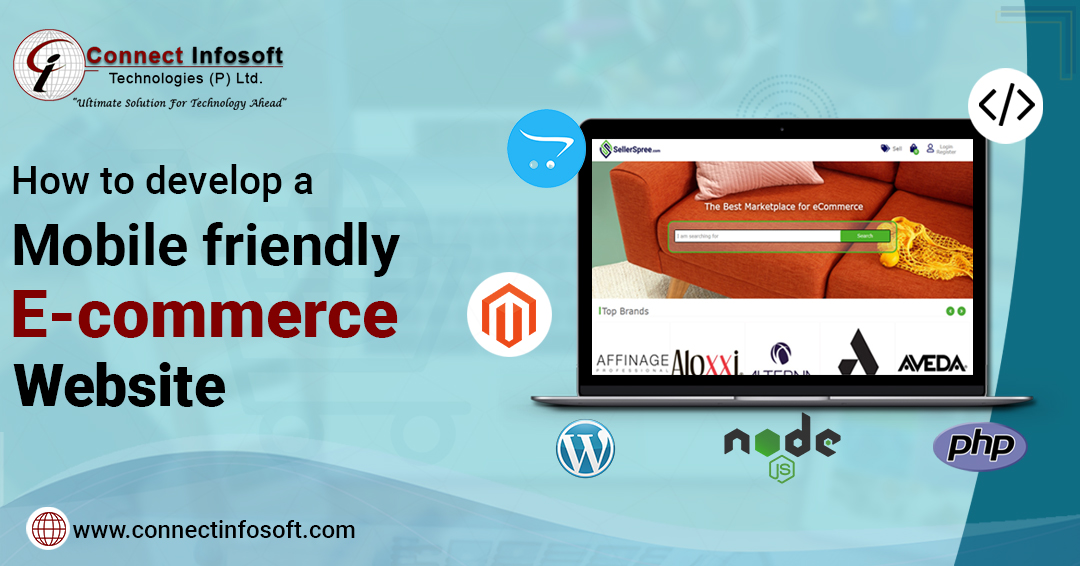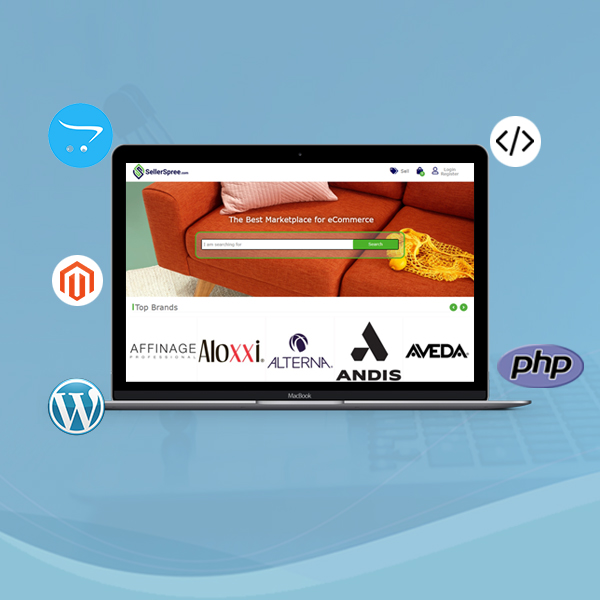How To Develop A Mobile-Friendly eCommerce Website - Connect Infosoft

Developing a mobile-friendly eCommerce website requires careful planning and implementation to ensure a seamless user experience across different mobile devices.
Having an eCommerce website that is optimized for mobile users is becoming increasingly important for businesses. Mobile users now account for more than 50% of online traffic and it is essential to ensure that customers have a good user experience when browsing your eCommerce site. To help you create the perfect mobile-friendly eCommerce website, we've gathered expert tips from e-commerce development services and eCommerce Website Development professionals. In this blog post, we'll explore the best practices for optimizing your eCommerce website for mobile users.
Here's a step-by-step guide to help you develop a mobile-friendly eCommerce website:
-
Responsive Design:
Use a responsive web design approach that automatically adjusts the layout and content of your website based on the user's device screen size. This ensures your website looks and functions well on various devices, including smartphones and tablets.
-
Mobile-Optimized User Interface:
Create a user interface (UI) that is specifically tailored for mobile devices. Consider the smaller screen size and touch-based interactions. Use larger buttons, easy-to-read fonts and simplified navigation menus to enhance user experience.
-
Streamlined Checkout Process:
Optimize your checkout process for mobile users to minimize friction and encourage conversions. Simplify form fields, provide guest checkout options and enable popular mobile payment methods to streamline the process. Implement features like auto-fill to make it easier for users to enter their information.
-
Mobile Search Functionality:
Implement a search feature that allows mobile users to quickly find products. Include filters, sorting options and predictive search to enhance the user experience. Ensure the search bar is easily accessible and prominently displayed on the mobile interface.
-
Fast Loading Speed:
Mobile users expect fast-loading websites. Optimize your website's performance by minimizing file sizes, compressing images, leveraging browser caching and using content delivery networks (CDNs) to serve your content efficiently. Regularly test your website's speed using tools like Google PageSpeed Insights or GTmetrix.
-
Mobile-Friendly Navigation:
Design a simple and intuitive navigation menu that is easy to use on mobile devices. Utilize hamburger menus or slide-out menus to save screen space while providing access to important sections of your website. Incorporate breadcrumb navigation or a sticky navigation bar to help users navigate through the site effortlessly.
-
Touch-Friendly Interactions:
Consider touch-based interactions when designing your mobile eCommerce website. Ensure that buttons and links are large enough and properly spaced to avoid accidental clicks. Use swipe gestures for image galleries or product carousels to improve navigation.
-
Mobile Payment Integration:
Integrate popular mobile payment options such as Apple Pay, Google Pay, or PayPal to offer convenient and secure payment methods for mobile users. Streamlining the payment process will help improve conversion rates on mobile devices.
-
Cross-Browser and Device Testing:
Test your website thoroughly across various mobile devices, browsers and operating systems to ensure consistent functionality and display. Check for any layout issues, responsiveness problems, or usability glitches. Make necessary adjustments to ensure a seamless experience across different platforms.
Tips for Designing a Mobile-Friendly Ecommerce Website:
Designing a mobile-friendly eCommerce website is crucial in today's digital landscape, as mobile devices have become the primary means of online browsing and shopping for many users. Here are some tips to help you create a mobile-friendly eCommerce website:
-
Keep it Simple:
When it comes to mobile design, less is more. Avoid cluttering your mobile eCommerce website with too many graphics, buttons or pages. A minimalist design can make it easy for users to navigate and find what they're looking for.
-
Prioritize User Experience:
The success of an eCommerce website depends largely on user experience. Focus on designing a seamless mobile experience that is intuitive and easy to use. Consider working with an eCommerce web development company that has experience in designing mobile-optimized websites.
-
Use a Responsive Design:
A responsive website is a website that adapts to any screen size, whether it's a desktop or a mobile device. This is important because a website that is not responsive can make navigation difficult and cause users to leave your site. A responsive design can improve the user experience and increase conversion rates.
-
Optimize for Speed:
Speed is essential for any eCommerce website. Slow loading times can cause users to abandon your site, resulting in lost sales. Use tools like Google's PageSpeed Insights to test your website's speed and optimize it accordingly.
-
Ensure Security:
With the rise of mobile eCommerce, it's important to ensure the security of your website. This includes using SSL encryption to protect customer information, implementing two-factor authentication and monitoring your website for security threats.
Creating a mobile-friendly user experience:
Looking to develop a mobile-friendly eCommerce website? Then, you need to focus on creating a user-friendly experience for mobile users. According to ECommerce development service experts, the mobile experience is crucial to your online store's success. If your website is not user-friendly, it could lead to a high bounce rate, decreased conversions and lost sales.
Here are some tips to ensure your mobile users have a positive shopping experience:
- Simplify Navigation: The navigation should be straightforward, clear and concise. Users should be able to find what they need easily, with minimal effort. Make sure your navigation bar is easy to access and your menus are short and sweet.
- Use Responsive Design: A responsive design ensures your website is compatible with different devices, screen sizes and resolutions. Your website should adapt to any screen size and content should be presented in a mobile-friendly manner.
- Keep Forms Simple: Forms should be minimal and easy to complete. Customers shouldn't have to enter a lot of information and the process should be as streamlined as possible. You don't want to lose a customer because they couldn't complete the checkout process on their mobile device. What resources are needed to design and develop a mobile-friendly e-commerce website?
Choosing and comparing different e-commerce platforms:
When choosing an e-commerce platform, it's important to consider your specific business needs, budget, technical expertise, scalability requirements and desired features. Here are some popular e-commerce platforms and a brief comparison to help you make an informed decision.
Shopify:
- Shopify is one of the most popular and user-friendly e-commerce platforms.
- It offers a wide range of professionally designed templates and extensive app integrations.
- Suitable for small to medium-sized businesses with a focus on ease of use and simplicity.
- Provides built-in hosting, security and payment gateway options.
- Offers scalability options for growing businesses.
WooCommerce:
- WooCommerce is a flexible and customizable e-commerce plugin for WordPress.
- It requires a self-hosted WordPress website to function.
- Offers a vast library of themes and extensions for customization.
- Suitable for businesses already using WordPress or those with specific customization needs.
- Offers a large community and developer support.
Magento:
- Magento is a powerful and feature-rich e-commerce platform.
- It offers a high level of customization and scalability.
- Suitable for medium to large businesses with complex requirements.
- Provides advanced features such as multi-store functionality, robust inventory management and extensive third-party integrations.
- Requires technical expertise and dedicated hosting.
BigCommerce:
- BigCommerce is a comprehensive and scalable e-commerce platform.
- It offers a wide range of built-in features and marketing tools.
- Suitable for businesses of all sizes, including enterprise-level.
- Provides responsive themes and customization options.
- Offers reliable hosting, security and integration capabilities.
Squarespace:
- Squarespace is a website builder with built-in e-commerce functionality.
- It offers visually-appealing templates and a user-friendly interface.
- Suitable for small businesses or individuals with simple e-commerce needs.
- Provides integrated hosting, security and marketing features.
- It is limited in terms of scalability and advanced customization options.
These are just a few examples and there are other e-commerce platforms available as well. It's important to research and evaluate each platform based on your specific requirements before making a decision. Consider factors such as cost, ease of use, design flexibility, scalability, SEO capabilities, customer support and integration options to choose the platform that best suits your business.
